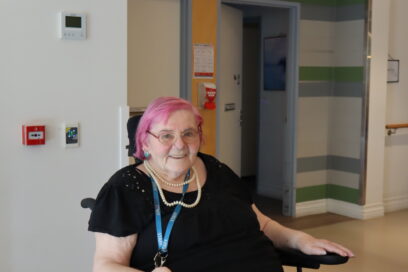Homelessness Week in August is an annual week to raise awareness of people experiencing homelessness, the issues people face and the actions needed for solutions. This year’s theme was ‘housing ends homelessness’.
At Sacred Heart Mission, we help some of the most vulnerable people in our community, but safe and appropriate housing is critical to the success of our services and support.
This is why our service model framework works towards five interrelated client outcome areas, including housing, but also; health and wellbeing; independence; social participation; and economic participation.
People and Strategy General Manager Leanne Lewis says these outcomes represent the social determinants of ‘wellbeing’ that are critical to maintaining safe and appropriate housing.
“Drawing from 37 years of experience, Sacred Heart Mission knows housing people first and then linking them to the right support services is the key to solving homelessness,” Leanne says.
“If people can get into safe housing and have the right level of support to stay in their housing, they can address any physical and mental health issues and achieve personal goals that promote social and economic participation and independence.”
Sacred Heart Mission has spent the past four and a half years testing and developing an outcomes measurement tool to collect evidence of this work we do so we can show how we are assisting clients towards achieving these service model outcomes.
“It is vital to have a process for gathering data to assess our progress,” Leanne says.
“By reviewing the effectiveness of our programs and services, we can increase the impact of our services; particularly getting people housed and ultimately ending homelessness.”
With pro-bono support from Accenture, we developed a survey and custom-built measurement tool, known as TICSPOT (Trauma Informed Client Support and Planning Outcomes Tool), to capture, analyse and report on this data at an individual, program and organisational level.
“Case managers can use this tool to engage and support clients in setting and achieving their personal goals within the five outcome areas,” Leanne says.
“Using TICSPOT, clients can reflect on changes in their lives since working with us, as well as identify what they still want to focus on in order to sustain their independence in the community.”
Beyond the benefits it has to a clients’ progress, TICSPOT also means we can demonstrate the impact of our services, continue to build an evidence base for effective responses and ensure we are delivering high quality and trauma-informed services.
“We will be able to look at programs where clients are achieving great outcomes and replicate their successes in other areas of the organisation,” Leanne says.
“Similarly, we will have the opportunity to pinpoint where there is room for improvement.”
More than 500 client surveys have been carried out with TICSPOT, which has provided us with valuable information about what is working well, and what we can do better for the people we support.
“It was visually helpful, I could see my goals while I was with my case manager, I found that really useful,” one client remarks.
“It boosted my confidence as I could see the progress I was making.”
Sacred Heart Mission is participating in a sector working group, led by the Council for Homeless Persons, to influence the design and implementation of outcome measurement frameworks for the sector and state government.
Leanne is also presenting on our outcomes measurement journey at the National Housing Conference in Darwin in August.
Sacred Heart Mission programs focussed on housing outcomes
- Journey to Social Inclusion program: uses a rapid-housing approach and has a trauma-informed lens to service delivery, offering three years of intensive and individualised support to people to sustain housing.
- GreenLight Supportive Housing Program: works with people who have experienced long-term homelessness to sustain their housing and any challenges that may arise.
- St Kilda Intensive Outreach Team: works with people long-term to secure housing, set up their home and then address individual health and wellbeing issues so they can stay housed.
- Rooming House Plus Program: enables people with histories of chronic homelessness to break their cycle of disadvantage through the provision of long-term accommodation and the support needed to maintain housing.
- Homefront: a statewide crisis accommodation service for women aged 25 and over, without accompanying children.
- Bethlehem Community: provides medium to long-term accommodation with case management support, as well as social inclusion activities for women.
- Sacred Heart Community: differs from many aged care services as we support people from a younger age at our two residential facilities.
Assistance with Care and Housing program: provides targeted advocacy and support to older women and men who come to our Dining Hall.













